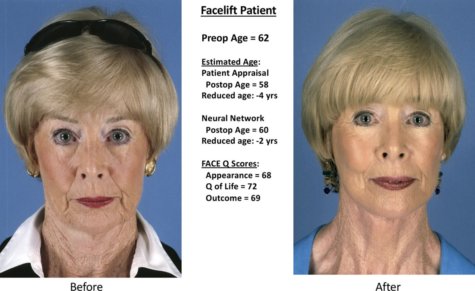HEMPSTEAD, N.Y. — Facelifts have one simple goal: make the patient look younger. However, is there really a way to tell how far plastic surgery has turned back the clock? While beauty may be in the eye of the beholder, a new study finds artificial intelligence can still put an actual number on someone’s facelift success.
Researchers from the Zucker School of Medicine at Hofstra say computer algorithms are not only capable of telling how old someone is by their facial features before surgery, but they can also put an objective number on how many years a facelift takes off their looks.
“Our study shows that currently available AI algorithms can recognize the success of facelifting, and even put a number on the reduction in years of perceived age,” says senior author and vice chairman of surgery James P. Bradley, MD, in a media release.
Surprisingly, this is a question patients are still asking quite frequently, even during the coronavirus pandemic. According to American Society of Plastic Surgeons, over 234,000 people had a facelift in 2020. To find an answer, researchers used a type of AI program called convolutional neural networks to examine the plastic surgery results of 50 facelift patients.
“By training on datasets containing millions of public images, these neural networks can learn to discern facial features with much higher ‘experience’ than a typical person,” Dr. Bradley explains.
People think facelifts are more effective than they really are

Study authors used four different, publicly available neural networks during their experiment. The AI program examined photos taken of each patient before their facelifts and one year after the procedures. Along with the computers, patients also graded their own appearance using a questionnaire which tried to estimate how much younger they looked. Researchers note all of these patients were women and they had an average age of 58.7 years at the time of surgery.
Results reveal the AI system identified each person’s “before” age with 100 percent accuracy. As for the “after” photos, computer algorithms conclude that a facelift takes 4.3 years off someone’s appearance.
This number is significantly lower than what the patients themselves thought of their surgeon’s handy work. Participants believed their facelifts took 6.7 years off their age on average.
“Patients may tend to overestimate how much younger they look after facelift surgery – perhaps reflecting their emotional and financial investment in the procedure,” Dr. Bradley says.
Satisfaction guaranteed?
Despite not taking off as much age as artificial intelligence sees, patients are generally pleased with the outcomes from a facelift. On the FACE-Q questionnaire, participants graded their surgeries as a 75 out of 100 for facial appearance and over 80 for quality of life.
“The younger the AI program perceives a patient’s age, the greater their satisfaction with the results of their facelift,” Dr. Bradley adds.
So while the outcomes of plastic surgery are still very much a matter of individual opinion, study authors believe using AI can give patients a “reliable estimate” of what to expect from their procedures.
“Together with powerful image analysis tools used in modern plastic surgery, neural networks may play a useful role in counseling patients and demonstrating successful results of facial rejuvenation procedures,” Dr. Bradley concludes. “We think that AI algorithms could also play a useful role for plastic surgeons in assessing their own results and comparing the outcomes of different techniques.”
The study appears in the journal Plastic and Reconstructive Surgery.
